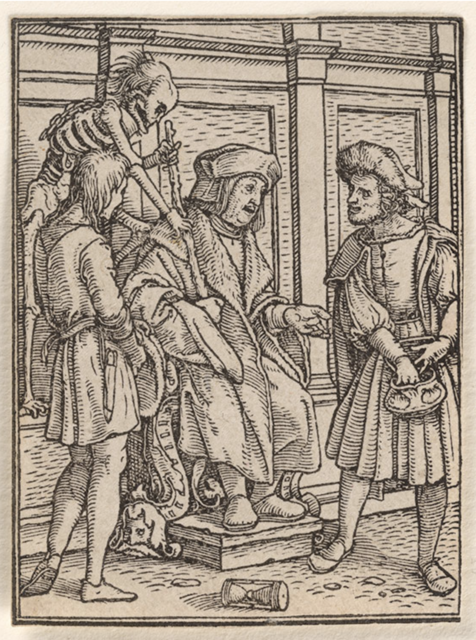
Hans Holbein the Younger, A Lady with a Squirrel and a Starling (Anne Lovell?), oil on panel, ca. 1526–28 (National Gallery, London)
CAPTURING HOLBEIN: THE ARTIST IN CONTEXT
The Morgan Library & Museum, Gilder Lehrman Hall
225 Madison Ave. at Thirty-Sixth St.
Friday, May 6, $30, 2:00 – 6:30
“Capturing Holbein: The Artist in Context” continues through May 15
www.themorgan.org
“Welcome to the house / to the Haus of Holbein / Ja, ooh ja, das ist gut / Ooh ja, ja / The Haus of Holbein,” the characters sing in the hit Broadway musical Six, about the six wives of Henry VIII, the king for whom Hans Holbein the Younger (1497/98–1543) was the court painter.

Hans Lützelburger, after designs by Hans Holbein the Younger, Death and the Judge, woodcuts, ca. 1526 (the Metropolitan Museum of Art, New York, Rogers Fund, 1919)
Right now the Haus of Holbein is the Morgan Library, which is hosting the revelatory exhibition “Holbein: Capturing Character” through May 15. The German-Swiss Holbein was best known for his exquisitely detailed portraiture, including his remarkable 1527 depiction of Sir Thomas More, on loan here from the Frick. These portraits — A Lady with a Squirrel and a Starling (Anne Lovell?), A Member of the Wedigh Family, the miniatures Portrait of a Court Official of Henry VIII and Simon George, Roundel Portrait of the Printer Johann Froben of Basel, a painting of his early supporter Erasmus, which features the phrase “I yield to none” — go deep inside his subjects, becoming not mere representations in oil but a look into their souls. In her catalog essay “The Pictorial Eloquence of Hans Holbein the Younger,” J. Paul Getty Museum curator Anne T. Woollett writes that the exhibit “considers how the artist engaged with the philosophical debate about the superiority of the written word over the painted image to convey an individual’s interior qualities. Holbein’s masterful manipulation of the viewing experience emerges through close examination of his drawings, paintings, and related works of art such as portrait medals and symbolic jewels.”
But amid all this glorious work, it is Holbein’s 1524–25 print series, “Images of Death,” that is most memorable. A collaboration with blockcutter Hans Lützelburger and based on the medieval danse macabre, “Images of Death” is a startling narrative that follows the skeletal Death as he confronts royals and peasants alike, holding aloft an hourglass, engaging in battle, playing instruments, and leading people to their ultimate, inescapable fate, which comes to everyone regardless of their wealth or power.
On May 6 from 2:00 to 6:30, the Morgan is hosting the afternoon symposium “Capturing Holbein: The Artist in Context” in the museum’s Gilder Lehrman Hall; the program consists of six presentations in addition to the keynote lecture, “Becoming Holbein: Art and Portraiture,” by Jochen Sander of the Städel Museum: “Flexibility and Rapport: Holbein’s Working Method” by Woollett, “Inherent Ingenuity: Holbein’s Portrait of Georg Gisze (1532)” by Alexander Marr of Cambridge University, “Drawing in Time: Portrait Studies by Holbein and His Contemporaries” by the Morgan’s Austėja Mackelaitė, “The Contexts for Character in Holbein’s Narrative Prints” by Jeanne Nuechterlein of York University, “Metalwork Design Drawings from the Circle of Hans Holbein the Younger” by Olenka Horbatsch of the British Museum, and “‘Foolish Curiosity’: Holbein’s Earliest English Afterlives” by Adam Eaker of the Met.
Even if you can’t make the symposium — perhaps the Morgan will record it and make it available later online — be sure to see the exhibit, co-organized with the Getty, before it leaves town. As Morgan director Colin B. Bailey says in the above video, “[Holbein] was the greatest artist of the sixteenth century working in England but really one of the greatest artists of the European Renaissance. His works are rare, they’re fragile, they’re precious, they’re rarely lent, and that’s why this exhibition is such an opportunity.”
